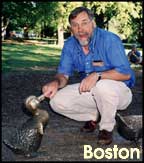Maine State Flag

About My State
(you can even sing the song) |
You'll need the free Acrobat Reader to read, print or save the printable brochure. |
 |
|
|
|
|
|
|
Authored Articles,
Movies and Adult Books |
|
|
|
|
|
<> <> <> <> <> <> <> <> <> <> <> <> <> <> <> <> <> <> <>
Introduction
|
That's Bruce?
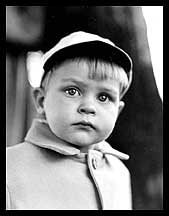
Boston, MA |
It really is.
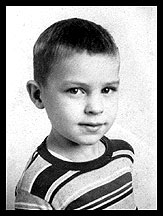 Bangor, ME
Bangor, ME
|
See?

Almost Kennebunk, ME |
I was raised in Maine, but was born in Boston and lived there until the first grade. We moved to Bangor for my elementary school years, then to Kennebunk for junior high. I graduated from Kennebunk High School and I graduated from the University of Maine at Orono with a Bachelor of Science in biology.
|
I sold my first photo in 1965 while I was still a teenager. It was a view of the house on Walker's Point in Kennebunkport. One of the house's residents contacted me. He had seen my photograph on exhibition at an after-theatre classical music coffeehouse. He wanted to purchase six prints. At $5.00 per print that meant $30.00! I was thrilled. I could buy more paper and chemicals to make more photos.
At the time it was just another house, but it subsequently became a popular sightseeing spot. It's the summer residence of President George Herbert Walker Bush. In August 2001 I had the opportunity to ask Barbara Bush who she thought had bought the photographs. She said it must've been Burt (sp?) Walker, George's cousin. |
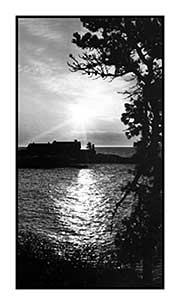 |
Back to the top
In my early twenties I won a national photo contest sponsored by Bayers Children's Aspirin to depict "the emotional appeal of children." I share the photo when I speak. It is a portrait of my son, three-year-old Brett, eating a hard-boiled egg. The Grand Prize was an all-expenses-paid family trip to Hawaii! I had yet to start my first children's book, which would coincidentally feature Brett in Finestkind o' Day.
Since then I've photographed more than forty children's books. I've traveled the world from Alaska to Antarctica to Bonaire to Culebra to Iceland and across the United States to photograph the wonders of nature and simple concepts for my books. I'm fortunate to have so many of them acclaimed with honors and awards.
I teach a course open to the public, Writing, Illustrating & Publishing Children's Picture Books, at the University of New Hampshire. I'm quite pleased that two of my students have been successfully published. I speak at schools and conferences across the United States and Europe. I also led summer tours to Iceland from 1997-2000 to see puffins and horses and where the books were photographed.
I'm a member of the Author's Guild and the Society of Children's Book Writers and Illustrators and served as a judge for the S.C.B.W.I. Golden Kite awards in 1994. My photographic work has appeared in exhibits throughout the country, as well as in magazines such as DownEast, Life, Natural History, People, Reader's Digest, US, and Yankee.
Back to the top |
<> <> <> <> <> <> <> <> <> <> <> <> <> <> <> <> <> <> <>
Authored Articles - click on link for full article
Our Winters on a Maine Island, DownEast, January 1977.
Photographer or Photo-illustrator: What's the Difference?, School Library Journal, Feb. 1991.
Accuracy in Books for Young Readers: From First to Last Check, The New Advocate, spring 1993.
Tern Turn-on, Natural History, June 1993.
Playing with Math, C.B.C. Features, The Children's Book Council, Summer-Fall 1993.
Learning from Reviews,
The Journal of the Children's Literature Council of Pennsylvania
Volume 3, Number 1, 1989
Letter to the Editor, Andrew Wyeth's Friend
DownEast, The Magazine of Maine, November 2001, Vol. 48 Number 4
Books Made into Movies
The Remarkable Riderless Runaway Tricycle, 1982, Evergreen Firehouse Production, Phoenix Films.
Adult Books
Punography, Penguin, 1978 - featured in Life magazine, January 1979.
Punography Too, Penguin, 1980 - featured in Reader's Digest magazine, July 1981.
Back to the top
|
<> <> <> <> <> <> <> <> <> <> <> <> <> <> <> <> <> <> <>
Autobiographical Sketch |
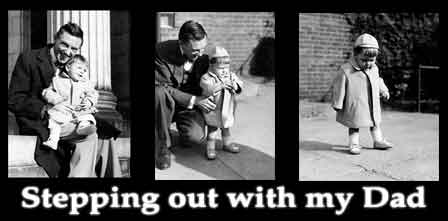 |
My father, Frank Harold McMillan, Jr., watched me stepping out. Later I would not only watch my son stepping out but after I started into my career with children's books I would photograph my neighbor, Evan, as he learned to walk. Then my children's books career led me to discover Iceland, one of the most beautiful places in the world to really step out and hike.
When I was a child, I loved to read. That's how I learned to appreciate the written word. I'd discover authors and read all of their books. I bicycled downtown to Bangor, Maine, and with my dollar, bought a Franklin W. Dixon book. Then I went back every week with my allowance until I'd read all the others in his Hardy Boys series. (I didn't know it then but Dixon was a pseudonym for the in-house editors who wrote each book using the same style.) I read my mother's original editions of Laura Lee Hope's Bobbsey Twins (another editors-as-author formula series). We moved to Kennebunk and I read one Albert Payson Terhune collie book (a real author), and then all of the others from the Kennebunk library.
Back to the top
I didn't learn to write until I was a big kid. My primary and secondary teachers had taught me to appreciate language, but I never had to write much in school. After I graduated from college, and after I'd been a producer and director at a Maine public television station, I stayed in Maine as an island caretaker on McGee Island off the coast of Port Clyde, Maine. There was neither electricity nor running water. In the summers I tended the island, and in the winters I taught myself to write. I practiced for two winters. I didn't write to produce a finished product. I simply wrote to improve my skills. At the end of my stay I wrote my first published work, an article for DownEast Magazine, Our Winters on a Maine Island. |
From being photographed to taking the photograph.
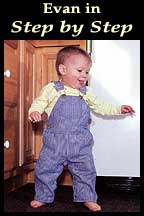
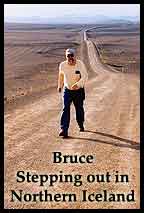
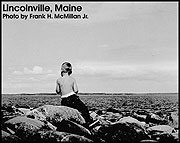
My father was a member of the Boston Camera Club and I often was a subject. I'm looking out at the ocean and perhaps beyond, ironically toward Iceland. |
When it was time to leave the island, I outlined what was to become my first book, Finestkind o' Day: Lobstering in Maine, and photographed it during my last few weeks on McGee. It featured my son, pre-school Brett. After I moved ashore, I wrote the first draft. Then I rewrote it many times. I learned from experience that's what writing is all about - rewriting.
Back to the top
|
When I was a child, my father, Frank H. McMillan Jr., sparked my interest in photography. He provided the tools, and always answered my questions. On my fifth birthday he gave me a simple camera and showed me how to use it on our vacations to Maine.
When I was nine my dad gave me a professional camera, a Rolleicord, for Christmas. At first I tended to be a little more creative with the Rolleicord than he thought I should be. He wasn't too pleased when I tried to photograph a burning Christmas candle - looking down at the flame from above - not too good for the lens.
With my father's guidance, my photographic skills improved. In high school I took pictures for both the school newspaper and yearbook. I even made a camera for a science project, a pinhole camera, using ordinary cardboard. I took a picture with it of my high school. I still have that picture and often share it with young audiences at schools I visit.
Want to make one too?
Here's how to make pinhole camera
How to make one from an oatmeal box.
How to make one using a film cartridge
- the film's already loaded - cool.
Kodak's Instructions
Back to the top
|
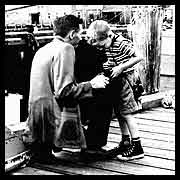

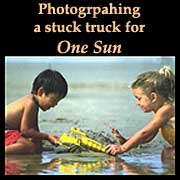 |
My Son and late Father
Who's imitating who?
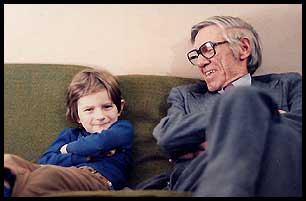
Y es, that's me with the camera.

|
My father photographed me as a child. I've done the same thing with my son, Brett. He was the boy featured in Finestkind o' Day and as a sixth grader was my coauthor for Puniddles. When he was in high school I spent the winter seasons - yes that's me with the camera - photographing Brett at his wrestling matches. Brett's the one on top, of course. He still has the photographic books I made of his wrestling matches. |
| When starting a book project, I thoroughly research and study the subject first. Then, I simply begin photographing or writing. Sometimes the words come first; other times it's the photographs. Either way, I just start. |
 |
I built the main part of my home the same way I make a book. I learned all I could about my subject. Then I just started by first designing and then constructing my home. Twelve years later I completed my task - my home. It's where I still live and work. I've added on to it with a garage and office, though by now I'd decided to spend more time on making books and hire someone to do the building.
What you don't see in my books are all the pictures that didn't make it past my critical eye. I take many more bad pictures than people can imagine - really. I don't mind failing hundreds of times if in the end I get the perfect photograph of a whale breaching or a puffin flying. Just as it is with my writing, I keep doing it over and over until I feel that it's right. However, there are times when I can't reasonably do it over, such as my trip to Antarctica where I photographed Summer Ice, Penguins at Home, and Puffins Climb, Penguins Rhyme, or in Iceland when photographing Days of the Ducklings. On those occasions I take as many pictures as possible when I'm there. I took more than six thousand photos on those Antarctic and Icelandic expeditions.
Back to the top
|
Here I am building away, nail by nail, laying the oak flooring for the living room.

Can you see me in this picture?
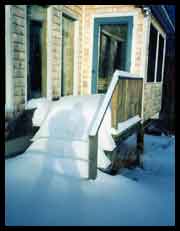 |
| A part of me, like most authors, is in each of my books. Based on my background and college degree in biology, my interest in the natural world is evident. Counting Wildflowers was about my fascination with wildflowers, and it became my own taxonomy lesson. Growing Colors was an extension of my interest in orchards and gardens. Going on a Whale Watch was my way of introducing readers to my newfound neighbors, the whales off the coast of Maine. My interest in baby animals and their names took me to San Diego and St. Louis where I photographed The Baby Zoo. However, there are certain animals that seem to especially pique my curiosity and photographic eye, and I'm not even sure why. It's birds. |
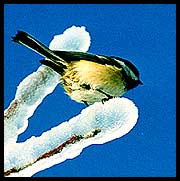 |
< Chickadee
in
winter
Goldfinch
in
summer >
|
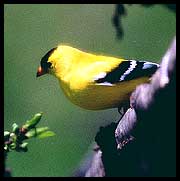 |
Feeders hang on the plum tree outside my kitchen window. I watch the chickadees, hummingbirds, goldfinches and all the other visitors. I often play a game of trying to spot at least four species when I glance out my window, and most seasons I succeed.
I've gone to the ends of the world to observe birds and photograph them. I walked with penguins at the bottom of the world in Antarctica for Summer Ice, and Penguins at Home. I sat with puffins at the top of the world in Iceland for Nights of the Pufflings and Puffins Climb, Penguins Rhyme. I've been back to Iceland to photograph wild eider ducks and ducklings for Days of the Ducklings. I traveled near the equator to observe, study, and photograph flamingos on Bonaire, an island off the coast of Venezuela for Wild Flamingos. But I don't always have to go that far to find fascinating bird subjects. I've spent long summer days in Kennebunk, Maine photographing the Maine-endangered least terns for A Beach for the Birds.
Perhaps my interest in birds has to do with the fact that, unlike other animals I've worked with, I'm not allergic to them. For Kitten Can… I hired my twelve-year-old son, Brett, as my kitten handler. For Mouse Views I hired a junior high student, Jessica Massanari, as my official mouse handler.
The rural Maine setting I live in is reflected in my books. On my daily trip to pick up the mail, I pass by our former post office where the tree that I photographed for The Weather Sky still stands. Up the road I photographed fruits and vegetables in Harry Boothby's garden for Growing Colors. When I was shooting that book, Harry was all smiles when I'd show up with my camera. He knew part of his garden - the part I wanted to be literally picture-perfect - was soon going to be weed-free courtesy of Bruce.
My books demonstrate experiments with different artistic styles and techniques. I photographed Grandfather's Trolley in black and white, and then hand tinted the photos with oil colors, just as they did in the trolley era. Growing Colors was for me an exploration of color and how far I could take it within the limits of conventional color film. Mouse Views was a lighting challenge: make the photos look natural so that no reader will realize the entire book is photographed using electronic flash.
Back to the top
|
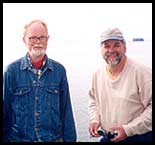
Óskar Sigurðsson
Lighthouse keeper of Stórhöfði
who has banded more than 45,000 puffins. |
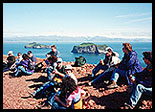
The 2000 Puffin Tour
I led to Iceland.
Picnic on a volcano.
Glacier in the distance. |
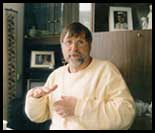
Fúsi, remember at your sister's when I was surprised by being photographed while explaining how the camera works? |
If I can find an excuse to go to Iceland, I do. I've photographed five books up there. I feel at home there. I led tours from 1997 to 2000 up there for teachers and librarians and puffin lovers. Tour members participated in the annual puffling rescue. I may do it again if demand warrants it and people contact Dr. Mary Lou White of Book Adventures through this page:
Bruce McMillan's Puffin Tour to Iceland
1997 Tour Member's Web Page
In Iceland I had to be even more creative with my light sources. Nights of the Pufflings was a nighttime photographic challenge. In the darkness of the northern night I improvised and used the light beams from two cars' head lamps aimed at the girl nestling the rescued puffling in her arms.
In addition to writing and photographing my books, I also do something that most other writers and illustrators don't do. I design my own books. I take pride in their design and am especially pleased when reviewers - as they have many times - comment on the "well-designed book." Mary Had a Little Lamb, in keeping with the contemporary retelling of the old classic, was designed with hand-drawn borders to set the book back in time. In Nights of the Pufflings, A Beach for the Birds, and Summer Ice the photos are chosen for both content and the interaction between them on the two-page spread. The viewer's eye is subtly directed from photo to photo.
Back to the top
|
With Nights of the Puffling's Halla's father. Hæ hæ Óli.
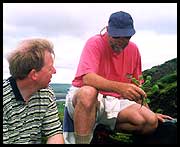
In the same day you can go from shorts to winter jackets as I did at this glacier. Scattered everywhere were pieces of obsidian, volcanic glass.
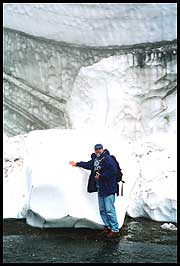 |

Another overcast day of waiting for the sun to photograph ducklings.
|
When I was in Iceland to shoot Days of the Ducklings (Houghton 2001) my mind was engaged as a photo-illustrator. I was shooting with the page layout in mind. I was shooting close-ups of the eider ducklings to mix with wide shots. But I was doing more than that. The tension in the nonfiction story is between the girl, Drífa (DREE vah), who is raising and nurturing the ducklings to restore the eider population to this small island. If they are to survive they can't be pets. It was this tension that I photographed. They are wild animals and must be raised as wild animals and not as pets, no matter how cute and cuddly they are. It was as a photo-illustrator that I planned my gradually increasing, distancing between Drífa and the ducklings for the conclusion of the book. It takes place in the final four photos of her. The fourth from the last shows Drífa complete figure in a portrait with the ducklings. Then she is seen as a reflection in the water with the ducklings. Next she's seen back-to looking on from afar. Finally, Drífa is seen only as a silhouette in a boat as she leaves the island and the ducklings, wild and free, on their new island home. The ducklings are going their way, to the left, and, as seen visually on the spread, and Drífa is going her way in the dory, to the right, together forming almost one sweeping line.
Back to the top
|
| In a way, I've already written my autobiography in book form. It's The Remarkable Riderless Runaway Tricycle. But I'm not the little boy in the story - I'm the tricycle. The tricycle has a vision. It knows where it wants to go and demonstrates great perseverance. Like the tricycle, I've also shown great perseverance in building my home, and in pursuing my career. No matter what anyone else thought, I believed in myself and persevered. Just as the tricycle did in the story, I stayed true to my vision. And like all of my books this one had - a happy ending. |
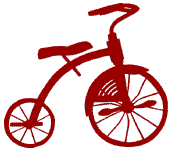 |
Back to the top
<> <> <> <> <> <> <> <> <> <> <> <> <> <> <> <> <> <> <>
Home: www.brucemcmillan.com |
